1. The Owners' Perspective1.1 IntroductionLike the five blind men encountering different parts of an elephant, each of the numerous participants in the process of planning, designing, financing, constructing and operating physical facilities has a different perspective on project management for construction. Specialized knowledge can be very beneficial, particularly in large and complicated projects, since experts in various specialties can provide valuable services. However, it is advantageous to understand how the different parts of the process fit together. Waste, excessive cost and delays can result from poor coordination and communication among specialists. It is particularly in the interest of owners to insure that such problems do not occur. And it behooves all participants in the process to heed the interests of owners because, in the end, it is the owners who provide the resources and call the shots. By adopting the viewpoint of the owners, we can focus our attention on the complete process of project management for constructed facilities rather than the historical roles of various specialists such as planners, architects, engineering designers, constructors, fabricators, material suppliers, financial analysts and others. To be sure, each specialty has made important advances in developing new techniques and tools for efficient implementation of construction projects. However, it is through the understanding of the entire process of project management that these specialists can respond more effectively to the owner's desires for their services, in marketing their specialties, and in improving the productivity and quality of their work. The introduction of innovative and more effective project management for construction is not an academic exercise. As reported by the "Construction Industry Cost Effectiveness Project" of the Business Roundtable: [1]
Improvement of project management not only can aid the construction industry, but may also be the engine for the national and world economy. However, if we are to make meaningful improvements, we must first understand the construction industry, its operating environment and the institutional constraints affecting its activities as well as the nature of project management. Back to top1.2 The Project Life CycleThe acquisition of a constructed facility usually represents a major capital investment, whether its owner happens to be an individual, a private corporation or a public agency. Since the commitment of resources for such an investment is motivated by market demands or perceived needs, the facility is expected to satisfy certain objectives within the constraints specified by the owner and relevant regulations. With the exception of the speculative housing market, where the residential units may be sold as built by the real estate developer, most constructed facilities are custom made in consultation with the owners. A real estate developer may be regarded as the sponsor of building projects, as much as a government agency may be the sponsor of a public project and turns it over to another government unit upon its completion. From the viewpoint of project management, the terms "owner" and "sponsor" are synonymous because both have the ultimate authority to make all important decisions. Since an owner is essentially acquiring a facility on a promise in some form of agreement, it will be wise for any owner to have a clear understanding of the acquisition process in order to maintain firm control of the quality, timeliness and cost of the completed facility. From the perspective of an owner, the project life cycle for a constructed facility may be illustrated schematically in Figure 1-1. Essentially, a project is conceived to meet market demands or needs in a timely fashion. Various possibilities may be considered in the conceptual planning stage, and the technological and economic feasibility of each alternative will be assessed and compared in order to select the best possible project. The financing schemes for the proposed alternatives must also be examined, and the project will be programmed with respect to the timing for its completion and for available cash flows. After the scope of the project is clearly defined, detailed engineering design will provide the blueprint for construction, and the definitive cost estimate will serve as the baseline for cost control. In the procurement and construction stage, the delivery of materials and the erection of the project on site must be carefully planned and controlled. After the construction is completed, there is usually a brief period of start-up or shake-down of the constructed facility when it is first occupied. Finally, the management of the facility is turned over to the owner for full occupancy until the facility lives out its useful life and is designated for demolition or conversion. 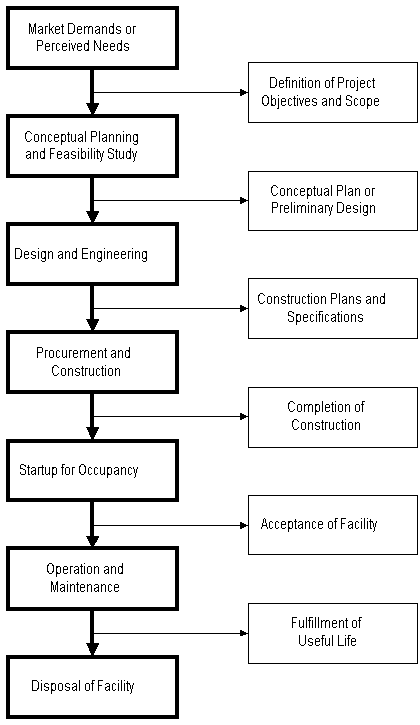
Figure 1-1: The Project Life Cycle of a Constructed Facility Of course, the stages of development in Figure 1-1 may not be strictly sequential. Some of the stages require iteration, and others may be carried out in parallel or with overlapping time frames, depending on the nature, size and urgency of the project. Furthermore, an owner may have in-house capacities to handle the work in every stage of the entire process, or it may seek professional advice and services for the work in all stages. Understandably, most owners choose to handle some of the work in-house and to contract outside professional services for other components of the work as needed. By examining the project life cycle from an owner's perspective we can focus on the proper roles of various activities and participants in all stages regardless of the contractual arrangements for different types of work. In the United States, for example, the U.S. Army Corps of Engineers has in-house capabilities to deal with planning, budgeting, design, construction and operation of waterway and flood control structures. Other public agencies, such as state transportation departments, are also deeply involved in all phases of a construction project. In the private sector, many large firms such as DuPont, Exxon, and IBM are adequately staffed to carry out most activities for plant expansion. All these owners, both public and private, use outside agents to a greater or lesser degree when it becomes more advantageous to do so. The project life cycle may be viewed as a process through which a project is implemented from cradle to grave. This process is often very complex; however, it can be decomposed into several stages as indicated by the general outline in Figure 1-1. The solutions at various stages are then integrated to obtain the final outcome. Although each stage requires different expertise, it usually includes both technical and managerial activities in the knowledge domain of the specialist. The owner may choose to decompose the entire process into more or less stages based on the size and nature of the project, and thus obtain the most efficient result in implementation. Very often, the owner retains direct control of work in the planning and programming stages, but increasingly outside planners and financial experts are used as consultants because of the complexities of projects. Since operation and maintenance of a facility will go on long after the completion and acceptance of a project, it is usually treated as a separate problem except in the consideration of the life cycle cost of a facility. All stages from conceptual planning and feasibility studies to the acceptance of a facility for occupancy may be broadly lumped together and referred to as the Design/Construct process, while the procurement and construction alone are traditionally regarded as the province of the construction industry. Owners must recognize that there is no single best approach in organizing project management throughout a project's life cycle. All organizational approaches have advantages and disadvantages, depending on the knowledge of the owner in construction management as well as the type, size and location of the project. It is important for the owner to be aware of the approach which is most appropriate and beneficial for a particular project. In making choices, owners should be concerned with the life cycle costs of constructed facilities rather than simply the initial construction costs. Saving small amounts of money during construction may not be worthwhile if the result is much larger operating costs or not meeting the functional requirements for the new facility satisfactorily. Thus, owners must be very concerned with the quality of the finished product as well as the cost of construction itself. Since facility operation and maintenance is a part of the project life cycle, the owners' expectation to satisfy investment objectives during the project life cycle will require consideration of the cost of operation and maintenance. Therefore, the facility's operating management should also be considered as early as possible, just as the construction process should be kept in mind at the early stages of planning and programming. Back to top1.3 Major Types of ConstructionSince most owners are generally interested in acquiring only a specific type of constructed facility, they should be aware of the common industrial practices for the type of construction pertinent to them. Likewise, the construction industry is a conglomeration of quite diverse segments and products. Some owners may procure a constructed facility only once in a long while and tend to look for short term advantages. However, many owners require periodic acquisition of new facilities and/or rehabilitation of existing facilities. It is to their advantage to keep the construction industry healthy and productive. Collectively, the owners have more power to influence the construction industry than they realize because, by their individual actions, they can provide incentives or disincentives for innovation, efficiency and quality in construction. It is to the interest of all parties that the owners take an active interest in the construction and exercise beneficial influence on the performance of the industry. In planning for various types of construction, the methods of procuring professional services, awarding construction contracts, and financing the constructed facility can be quite different. For the purpose of discussion, the broad spectrum of constructed facilities may be classified into four major categories, each with its own characteristics. Residential Housing ConstructionResidential housing construction includes single-family houses, multi-family dwellings, and high-rise apartments. During the development and construction of such projects, the developers or sponsors who are familiar with the construction industry usually serve as surrogate owners and take charge, making necessary contractual agreements for design and construction, and arranging the financing and sale of the completed structures. Residential housing designs are usually performed by architects and engineers, and the construction executed by builders who hire subcontractors for the structural, mechanical, electrical and other specialty work. An exception to this pattern is for single-family houses which may be designed by the builders as well. The residential housing market is heavily affected by general economic conditions, tax laws, and the monetary and fiscal policies of the government. Often, a slight increase in total demand will cause a substantial investment in construction, since many housing projects can be started at different locations by different individuals and developers at the same time. Because of the relative ease of entry, at least at the lower end of the market, many new builders are attracted to the residential housing construction. Hence, this market is highly competitive, with potentially high risks as well as high rewards. 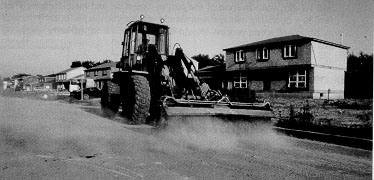
Figure 1-2: Residential Housing Construction (courtesy of Caterpillar, Inc.) Institutional and Commercial Building ConstructionInstitutional and commercial building construction encompasses a great variety of project types and sizes, such as schools and universities, medical clinics and hospitals, recreational facilities and sports stadiums, retail chain stores and large shopping centers, warehouses and light manufacturing plants, and skyscrapers for offices and hotels. The owners of such buildings may or may not be familiar with construction industry practices, but they usually are able to select competent professional consultants and arrange the financing of the constructed facilities themselves. Specialty architects and engineers are often engaged for designing a specific type of building, while the builders or general contractors undertaking such projects may also be specialized in only that type of building. Because of the higher costs and greater sophistication of institutional and commercial buildings in comparison with residential housing, this market segment is shared by fewer competitors. Since the construction of some of these buildings is a long process which once started will take some time to proceed until completion, the demand is less sensitive to general economic conditions than that for speculative housing. Consequently, the owners may confront an oligopoly of general contractors who compete in the same market. In an oligopoly situation, only a limited number of competitors exist, and a firm's price for services may be based in part on its competitive strategies in the local market. 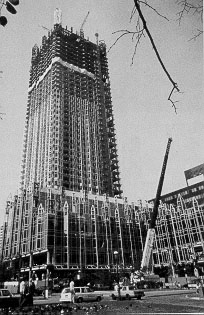
Figure 1-3: Construction of the PPG Building in Pittsburgh, Pennsylvania (courtesy of PPG Industries, Inc.) Specialized Industrial ConstructionSpecialized industrial construction usually involves very large scale projects with a high degree of technological complexity, such as oil refineries, steel mills, chemical processing plants and coal-fired or nuclear power plants. The owners usually are deeply involved in the development of a project, and prefer to work with designers-builders such that the total time for the completion of the project can be shortened. They also want to pick a team of designers and builders with whom the owner has developed good working relations over the years. Although the initiation of such projects is also affected by the state of the economy, long range demand forecasting is the most important factor since such projects are capital intensive and require considerable amount of planning and construction time. Governmental regulation such as the rulings of the Environmental Protection Agency and the Nuclear Regulatory Commission in the United States can also profoundly influence decisions on these projects. 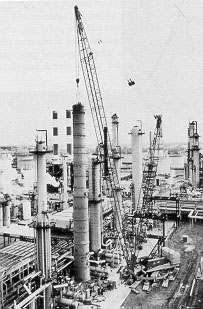
Figure 1-4: Construction of a Benzene Plant in Lima, Ohio (courtesy of Manitowoc Company, Inc.) Infrastructure and Heavy ConstructionInfrastructure and heavy construction includes projects such as highways, mass transit systems, tunnels, bridges, pipelines, drainage systems and sewage treatment plants. Most of these projects are publicly owned and therefore financed either through bonds or taxes. This category of construction is characterized by a high degree of mechanization, which has gradually replaced some labor intensive operations. The engineers and builders engaged in infrastructure construction are usually highly specialized since each segment of the market requires different types of skills. However, demands for different segments of infrastructure and heavy construction may shift with saturation in some segments. For example, as the available highway construction projects are declining, some heavy construction contractors quickly move their work force and equipment into the field of mining where jobs are available. 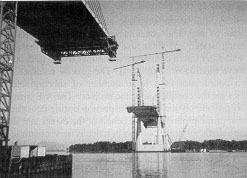
Figure 1-5: Construction of the Dame Point Bridge in Jacksonville, Florida (courtesy of Mary Lou Maher) Back to top 1.4 Selection of Professional ServicesWhen an owner decides to seek professional services for the design and construction of a facility, he is confronted with a broad variety of choices. The type of services selected depends to a large degree on the type of construction and the experience of the owner in dealing with various professionals in the previous projects undertaken by the firm. Generally, several common types of professional services may be engaged either separately or in some combination by the owners. Financial Planning ConsultantsAt the early stage of strategic planning for a capital project, an owner often seeks the services of financial planning consultants such as certified public accounting (CPA) firms to evaluate the economic and financial feasibility of the constructed facility, particularly with respect to various provisions of federal, state and local tax laws which may affect the investment decision. Investment banks may also be consulted on various options for financing the facility in order to analyze their long-term effects on the financial health of the owner organization. Architectural and Engineering FirmsTraditionally, the owner engages an architectural and engineering (A/E) firm or consortium as technical consultant in developing a preliminary design. After the engineering design and financing arrangements for the project are completed, the owner will enter into a construction contract with a general contractor either through competitive bidding or negotiation. The general contractor will act as a constructor and/or a coordinator of a large number of subcontractors who perform various specialties for the completion of the project. The A/E firm completes the design and may also provide on site quality inspection during construction. Thus, the A/E firm acts as the prime professional on behalf of the owner and supervises the construction to insure satisfactory results. This practice is most common in building construction. In the past two decades, this traditional approach has become less popular for a number of reasons, particularly for large scale projects. The A/E firms, which are engaged by the owner as the prime professionals for design and inspection, have become more isolated from the construction process. This has occurred because of pressures to reduce fees to A/E firms, the threat of litigation regarding construction defects, and lack of knowledge of new construction techniques on the part of architect and engineering professionals. Instead of preparing a construction plan along with the design, many A/E firms are no longer responsible for the details of construction nor do they provide periodic field inspection in many cases. As a matter of fact, such firms will place a prominent disclaimer of responsibilities on any shop drawings they may check, and they will often regard their representatives in the field as observers instead of inspectors. Thus, the A/E firm and the general contractor on a project often become antagonists who are looking after their own competing interests. As a result, even the constructibility of some engineering designs may become an issue of contention. To carry this protective attitude to the extreme, the specifications prepared by an A/E firm for the general contractor often protects the interest of the A/E firm at the expense of the interests of the owner and the contractor. In order to reduce the cost of construction, some owners introduce value engineering, which seeks to reduce the cost of construction by soliciting a second design that might cost less than the original design produced by the A/E firm. In practice, the second design is submitted by the contractor after receiving a construction contract at a stipulated sum, and the saving in cost resulting from the redesign is shared by the contractor and the owner. The contractor is able to absorb the cost of redesign from the profit in construction or to reduce the construction cost as a result of the re-design. If the owner had been willing to pay a higher fee to the A/E firm or to better direct the design process, the A/E firm might have produced an improved design which would cost less in the first place. Regardless of the merit of value engineering, this practice has undermined the role of the A/E firm as the prime professional acting on behalf of the owner to supervise the contractor. Design/Construct FirmsA common trend in industrial construction, particularly for large projects, is to engage the services of a design/construct firm. By integrating design and construction management in a single organization, many of the conflicts between designers and constructors might be avoided. In particular, designs will be closely scrutinized for their constructibility. However, an owner engaging a design/construct firm must insure that the quality of the constructed facility is not sacrificed by the desire to reduce the time or the cost for completing the project. Also, it is difficult to make use of competitive bidding in this type of design/construct process. As a result, owners must be relatively sophisticated in negotiating realistic and cost-effective construction contracts. One of the most obvious advantages of the integrated design/construct process is the use of phased construction for a large project. In this process, the project is divided up into several phases, each of which can be designed and constructed in a staggered manner. After the completion of the design of the first phase, construction can begin without waiting for the completion of the design of the second phase, etc. If proper coordination is exercised. the total project duration can be greatly reduced. Another advantage is to exploit the possibility of using the turnkey approach whereby an owner can delegate all responsibility to the design/construct firm which will deliver to the owner a completed facility that meets the performance specifications at the specified price. Professional Construction ManagersIn recent years, a new breed of construction managers (CM) offers professional services from the inception to the completion of a construction project. These construction managers mostly come from the ranks of A/E firms or general contractors who may or may not retain dual roles in the service of the owners. In any case, the owner can rely on the service of a single prime professional to manage the entire process of a construction project. However, like the A/E firms of several decades ago, the construction managers are appreciated by some owners but not by others. Before long, some owners find that the construction managers too may try to protect their own interest instead of that of the owners when the stakes are high. It should be obvious to all involved in the construction process that the party which is required to take higher risk demands larger rewards. If an owner wants to engage an A/E firm on the basis of low fees instead of established qualifications, it often gets what it deserves; or if the owner wants the general contractor to bear the cost of uncertainties in construction such as foundation conditions, the contract price will be higher even if competitive bidding is used in reaching a contractual agreement. Without mutual respect and trust, an owner cannot expect that construction managers can produce better results than other professionals. Hence, an owner must understand its own responsibility and the risk it wishes to assign to itself and to other participants in the process. Operation and Maintenance ManagersAlthough many owners keep a permanent staff for the operation and maintenance of constructed facilities, others may prefer to contract such tasks to professional managers. Understandably, it is common to find in-house staff for operation and maintenance in specialized industrial plants and infrastructure facilities, and the use of outside managers under contracts for the operation and maintenance of rental properties such as apartments and office buildings. However, there are exceptions to these common practices. For example, maintenance of public roadways can be contracted to private firms. In any case, managers can provide a spectrum of operation and maintenance services for a specified time period in accordance to the terms of contractual agreements. Thus, the owners can be spared the provision of in-house expertise to operate and maintain the facilities. Facilities ManagementAs a logical extension for obtaining the best services throughout the project life cycle of a constructed facility, some owners and developers are receptive to adding strategic planning at the beginning and facility maintenance as a follow-up to reduce space-related costs in their real estate holdings. Consequently, some architectural/engineering firms and construction management firms with computer-based expertise, together with interior design firms, are offering such front-end and follow-up services in addition to the more traditional services in design and construction. This spectrum of services is described in Engineering News-Record (now ENR) as follows: [2]
A common denominator of all firms entering into these new services is that they all have strong computer capabilities and heavy computer investments. In addition to the use of computers for aiding design and monitoring construction, the service includes the compilation of a computer record of building plans that can be turned over at the end of construction to the facilities management group of the owner. A computer data base of facilities information makes it possible for planners in the owner's organization to obtain overview information for long range space forecasts, while the line managers can use as-built information such as lease/tenant records, utility costs, etc. for day-to-day operations. Back to top1.5 Construction ContractorsBuilders who supervise the execution of construction projects are traditionally referred to as contractors, or more appropriately called constructors. The general contractor coordinates various tasks for a project while the specialty contractors such as mechanical or electrical contractors perform the work in their specialties. Material and equipment suppliers often act as installation contractors; they play a significant role in a construction project since the conditions of delivery of materials and equipment affect the quality, cost, and timely completion of the project. It is essential to understand the operation of these contractors in order to deal with them effectively. General ContractorsThe function of a general contractor is to coordinate all tasks in a construction project. Unless the owner performs this function or engages a professional construction manager to do so, a good general contractor who has worked with a team of superintendents, specialty contractors or subcontractors together for a number of projects in the past can be most effective in inspiring loyalty and cooperation. The general contractor is also knowledgeable about the labor force employed in construction. The labor force may or may not be unionized depending on the size and location of the projects. In some projects, no member of the work force belongs to a labor union; in other cases, both union and non-union craftsmen work together in what is called an open shop, or all craftsmen must be affiliated with labor unions in a closed shop. Since labor unions provide hiring halls staffed with skilled journeyman who have gone through apprentice programs for the projects as well as serving as collective bargain units, an experienced general contractor will make good use of the benefits and avoid the pitfalls in dealing with organized labor. Specialty ContractorsSpecialty contractors include mechanical, electrical, foundation, excavation, and demolition contractors among others. They usually serve as subcontractors to the general contractor of a project. In some cases, legal statutes may require an owner to deal with various specialty contractors directly. In the State of New York, for example, specialty contractors, such as mechanical and electrical contractors, are not subjected to the supervision of the general contractor of a construction project and must be given separate prime contracts on public works. With the exception of such special cases, an owner will hold the general contractor responsible for negotiating and fulfilling the contractual agreements with the subcontractors. Material and Equipment SuppliersMajor material suppliers include specialty contractors in structural steel fabrication and erection, sheet metal, ready mixed concrete delivery, reinforcing steel bar detailers, roofing, glazing etc. Major equipment suppliers for industrial construction include manufacturers of generators, boilers and piping and other equipment. Many suppliers handle on-site installation to insure that the requirements and contractual specifications are met. As more and larger structural units are prefabricated off-site, the distribution between specialty contractors and material suppliers becomes even less obvious. Back to top1.6 Financing of Constructed FacilitiesA major construction project requires an enormous amount of capital that is often supplied by lenders who want to be assured that the project will offer a fair return on the investment. The direct costs associated with a major construction project may be broadly classified into two categories: (1) the construction expenses paid to the general contractor for erecting the facility on site and (2) the expenses for land acquisition, legal fees, architect/engineer fees, construction management fees, interest on construction loans and the opportunity cost of carrying empty space in the facility until it is fully occupied. The direct construction costs in the first category represent approximately 60 to 80 percent of the total costs in most construction projects. Since the costs of construction are ultimately borne by the owner, careful financial planning for the facility must be made prior to construction. Construction FinancingConstruction loans to contractors are usually provided by banks or savings and loan associations for construction financing. Upon the completion of the facility, construction loans will be terminated and the post-construction facility financing will be arranged by the owner. Construction loans provided for different types of construction vary. In the case of residential housing, construction loans and long-term mortgages can be obtained from savings and loans associations or commercial banks. For institutional and commercial buildings, construction loans are usually obtained from commercial banks. Since the value of specialized industrial buildings as collateral for loans is limited, construction loans in this domain are rare, and construction financing can be done from the pool of general corporate funds. For infrastructure construction owned by government, the property cannot be used as security for a private loan, but there are many possible ways to finance the construction, such as general appropriation from taxation or special bonds issued for the project. Traditionally, banks serve as construction lenders in a three-party agreement among the contractor, the owner and the bank. The stipulated loan will be paid to the contractor on an agreed schedule upon the verification of completion of various portions of the project. Generally, a payment request together with a standard progress report will be submitted each month by the contractor to the owner which in turn submits a draw request to the bank. Provided that the work to date has been performed satisfactorily, the disbursement is made on that basis during the construction period. Under such circumstances, the bank has been primarily concerned with the completion of the facility on time and within the budget. The economic life of the facility after its completion is not a concern because of the transfer of risk to the owner or an institutional lender. Facility FinancingMany private corporations maintain a pool of general funds resulting from retained earnings and long-term borrowing on the strength of corporate assets, which can be used for facility financing. Similarly, for public agencies, the long-term funding may be obtained from the commitment of general tax revenues from the federal, state and/or local governments. Both private corporations and public agencies may issue special bonds for the constructed facilities which may obtain lower interest rates than other forms of borrowing. Short-term borrowing may also be used for bridging the gaps in long-term financing. Some corporate bonds are convertible to stocks under circumstances specified in the bond agreement. For public facilities, the assessment of user fees to repay the bond funds merits consideration for certain types of facilities such as toll roads and sewage treatment plants. [3] The use of mortgages is primarily confined to rental properties such as apartments and office buildings. Because of the sudden surge of interest rates in the late 1970's, many financial institutions offer, in addition to the traditional fixed rate long-term mortgage commitments, other arrangements such as a combination of debt and a percentage of ownership in exchange for a long-term mortgage or the use of adjustable rate mortgages. In some cases, the construction loan may be granted on an open-ended basis without a long-term financing commitment. For example, the plan might be issued for the construction period with an option to extend it for a period of up to three years in order to give the owner more time to seek alternative long-term financing on the completed facility. The bank will be drawn into situations involving financial risk if it chooses to be a lender without long-term guarantees. For international projects, the currency used for financing agreements becomes important. If financial agreements are written in terms of local currencies, then fluctuations in the currency exchange rate can significantly affect the cost and ultimately profit of a project. In some cases, payments might also be made in particular commodities such as petroleum or the output from the facility itself. Again, these arrangements result in greater uncertainty in the financing scheme because the price of these commodities may vary. Back to top1.7 Legal and Regulatory RequirementsThe owners of facilities naturally want legal protection for all the activities involved in the construction. It is equally obvious that they should seek competent legal advice. However, there are certain principles that should be recognized by owners in order to avoid unnecessary pitfalls. Legal ResponsibilitiesActivities in construction often involve risks, both physical and financial. An owner generally tries to shift the risks to other parties to the degree possible when entering into contractual agreements with them. However, such action is not without cost or risk. For example, a contractor who is assigned the risks may either ask for a higher contract price to compensate for the higher risks, or end up in non-performance or bankruptcy as an act of desperation. Such consequences can be avoided if the owner is reasonable in risk allocation. When risks are allocated to different parties, the owner must understand the implications and spell them out clearly. Sometimes there are statutory limitations on the allocation of liabilities among various groups, such as prohibition against the allocation of negligence in design to the contractor. An owner must realize its superior power in bargaining and hence the responsibilities associated with this power in making contractual agreements. Mitigation of ConflictsIt is important for the owner to use legal counselors as advisors to mitigate conflicts before they happen rather than to wield conflicts as weapons against other parties. There are enough problems in design and construction due to uncertainty rather than bad intentions. The owner should recognize the more enlightened approaches for mitigating conflicts, such as using owner-controlled wrap-up insurance which will provide protection for all parties involved in the construction process for unforeseen risks, or using arbitration, mediation and other extra-judicial solutions for disputes among various parties. However, these compromise solutions are not without pitfalls and should be adopted only on the merit of individual cases. Government RegulationTo protect public safety and welfare, legislatures and various government agencies periodically issue regulations which influence the construction process, the operation of constructed facilities, and their ultimate disposal. For example, building codes promulgated by local authorities have provided guidelines for design and construction practices for a very long time. Since the 1970's, many federal regulations that are related directly or indirectly to construction have been established in the United States. Among them are safety standards for workers issued by the Occupational Health and Safety Administration, environmental standards on pollutants and toxic wastes issued by the Environmental Protection Agency, and design and operation procedures for nuclear power plants issued by the Nuclear Regulatory Commission. Owners must be aware of the impacts of these regulations on the costs and durations of various types of construction projects as well as possibilities of litigation due to various contentions. For example, owners acquiring sites for new construction may be strictly liable for any hazardous wastes already on the site or removed from the site under the U.S. Comprehensive Environmental Response Compensation and Liability (CERCL) Act of 1980. For large scale projects involving new technologies, the construction costs often escalate with the uncertainty associated with such restrictions. Back to top1.8 The Changing Environment of the Construction IndustryThe construction industry is a conglomeration of diverse fields and participants that have been loosely lumped together as a sector of the economy. The construction industry plays a central role in national welfare, including the development of residential housing, office buildings and industrial plants, and the restoration of the nation's infrastructure and other public facilities. The importance of the construction industry lies in the function of its products which provide the foundation for industrial production, and its impacts on the national economy cannot be measured by the value of its output or the number of persons employed in its activities alone. To be more specific, construction refers to all types of activities usually associated with the erection and repair of immobile facilities. Contract construction consists of a large number of firms that perform construction work for others, and is estimated to be approximately 85% of all construction activities. The remaining 15% of construction is performed by owners of the facilities, and is referred to as force-account construction. Although the number of contractors in the United States exceeds a million, over 60% of all contractor construction is performed by the top 400 contractors. The value of new construction in the United States (expressed in constant dollars) and the value of construction as a percentage of the gross national products from 1950 to 1985 are shown in Figures 1-6 and 1-7. It can be seen that construction is a significant factor in the Gross National Product although its importance has been declining in recent years. [4] Not to be ignored is the fact that as the nation's constructed facilities become older, the total expenditure on rehabilitation and maintenance may increase relative to the value of new construction. 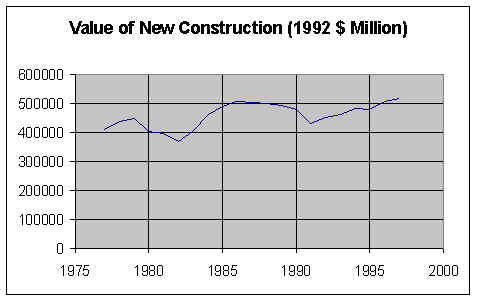
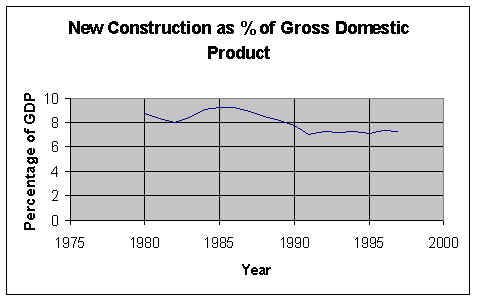
Owners who pay close attention to the peculiar characteristics of the construction industry and its changing operating environment will be able to take advantage of the favorable conditions and to avoid the pitfalls. Several factors are particularly noteworthy because of their significant impacts on the quality, cost and time of construction. New TechnologiesIn recent years, technological innovation in design, materials and construction methods have resulted in significant changes in construction costs. Computer-aids have improved capabilities for generating quality designs as well as reducing the time required to produce alternative designs. New materials not only have enhanced the quality of construction but also have shortened the time for shop fabrication and field erection. Construction methods have gone through various stages of mechanization and automation, including the latest development of construction robotics. The most dramatic new technology applied to construction has been the Internet and its private, corporate Intranet versions. The Internet is widely used as a means to foster collaboration among professionals on a project, to communicate for bids and results, and to procure necessary goods and services. Real time video from specific construction sites is widely used to illustrate construction progress to interested parties. The result has been more effective collaboration, communication and procurement. The effects of many new technologies on construction costs have been mixed because of the high development costs for new technologies. However, it is unmistakable that design professionals and construction contractors who have not adapted to changing technologies have been forced out of the mainstream of design and construction activities. Ultimately, construction quality and cost can be improved with the adoption of new technologies which are proved to be efficient from both the viewpoints of performance and economy. Labor ProductivityThe term productivity is generally defined as a ratio of the production output volume to the input volume of resources. Since both output and input can be quantified in a number of ways, there is no single measure of productivity that is universally applicable, particularly in the construction industry where the products are often unique and there is no standard for specifying the levels for aggregation of data. However, since labor constitutes a large part of the cost of construction, labor productivity in terms of output volume (constant dollar value or functional units) per person-hour is a useful measure. Labor productivity measured in this way does not necessarily indicate the efficiency of labor alone but rather measures the combined effects of labor, equipment and other factors contributing to the output. While aggregate construction industry productivity is important as a measure of national economy, owners are more concerned about the labor productivity of basic units of work produced by various crafts on site. Thus, an owner can compare the labor performance at different geographic locations, under different working conditions, and for different types and sizes of projects. Construction costs usually run parallel to material prices and labor wages. Actually, over the years, labor productivity has increased in some traditional types of construction and thus provides a leveling or compensating effect when hourly rates for labor increase faster than other costs in construction. However, labor productivity has been stagnant or even declined in unconventional or large scale projects. Public ScrutinyUnder the present litigious climate in the United States, the public is increasingly vocal in the scrutiny of construction project activities. Sometimes it may result in considerable difficulty in siting new facilities as well as additional expenses during the construction process itself. Owners must be prepared to manage such crises before they get out of control. Figure 1-8 can serve to indicate public attitudes towards the siting of new facilities. It represents the cumulative percentage of individuals who would be willing to accept a new industrial facility at various distances from their homes. For example, over fifty percent of the people surveyed would accept a ten-story office building within five miles of their home, but only twenty-five percent would accept a large factory or coal fired power plant at a similar distance. An even lower percentage would accept a hazardous waste disposal site or a nuclear power plant. Even at a distance of one hundred miles, a significant fraction of the public would be unwilling to accept hazardous waste facilities or nuclear power plants. 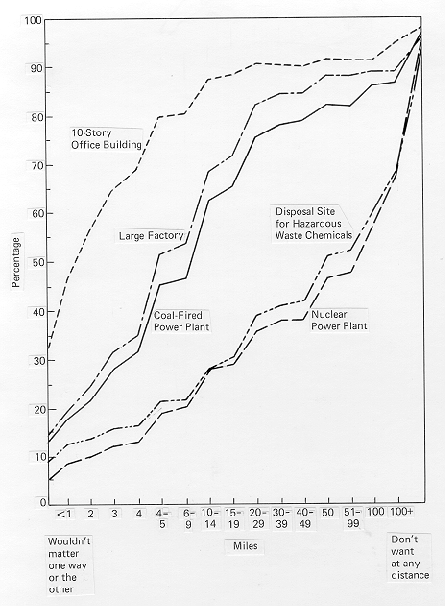
the Eleventh Annual Report of the Council on Environmental Quality, U.S. Government Printing Office, Washington, DC, December 1980.) This objection to new facilities is a widespread public attitude, representing considerable skepticism about the external benefits and costs which new facilities will impose. It is this public attitude which is likely to make public scrutiny and regulation a continuing concern for the construction industry. International CompetitionA final trend which deserves note is the increasing level of international competition in the construction industry. Owners are likely to find non-traditional firms bidding for construction work, particularly on large projects. Separate bids from numerous European, North American, and Asian construction firms are not unusual. In the United States, overseas firms are becoming increasingly visible and important. In this environment of heightened competition, good project management and improved productivity are more and more important. A bidding competition for a major new offshore drilling platform illustrates the competitive environment in construction. As described in the Wall Street Journal: [5]
The winning bidder arranged overseas fabrication of the rig, kept overhead costs low, and proposed a novel assembly procedure by which construction equipment was mounted on completed sections of the platform in order to speed the completion of the entire structure. The result was lower costs than those estimated and bid by traditional firms. Of course, U.S. firms including A/E firms, contractors and construction managers are also competing in foreign countries. Their success or failure in the international arena may also affect their capacities and vitality to provide services in the domestic U.S. market. Contractor Financed ProjectsIncreasingly, some owners look to contractors or joint ventures as a resource to design, to build and to finance a constructed facility. For example, a utility company may seek a consortium consisting of a design/construct firm and a financial investment firm to assume total liability during construction and thereby eliminate the risks of cost escalation to ratepayers, stockholders and the management. On the other hand, a local sanitation district may seek such a consortium to provide private ownership for a proposed new sewage treatment plant. In the former case, the owner may take over the completed facility and service the debt on construction through long-term financing arrangements; in the latter case, the private owner may operate the completed facility and recover its investment through user fees. The activities of joint ventures among design, construction and investment firms are sometimes referred to as financial engineering. This type of joint venture has become more important in the international construction market where aggressive contractors often win contracts by offering a more attractive financing package rather than superior technology. With a deepening shadow of international debts in recent years, many developing countries are not in a position to undertake any new project without contractor-backed financing. Thus, the contractors or joint ventures in overseas projects are forced into very risky positions if they intend to stay in the competition. Back to top1.9 The Role of Project ManagersIn the project life cycle, the most influential factors affecting the outcome of the project often reside at the early stages. At this point, decisions should be based on competent economic evaluation with due consideration for adequate financing, the prevalent social and regulatory environment, and technological considerations. Architects and engineers might specialize in planning, in construction field management, or in operation, but as project managers, they must have some familiarity with all such aspects in order to understand properly their role and be able to make competent decisions. Since the 1970's, many large-scale projects have run into serious problems of management, such as cost overruns and long schedule delays. Actually, the management of megaprojects or superprojects is not a practice peculiar to our time. Witness the construction of transcontinental railroads in the Civil War era and the construction of the Panama Canal at the turn of this century. Although the megaprojects of this generation may appear in greater frequency and present a new set of challenge, the problems are organizational rather than technical. As noted by Hardy Cross: [6]
As engineers advance professionally, they often spend as much or more time on planning, management and other economic or social problems as on the traditional engineering design and analysis problems which form the core of most educational programs. It is upon the ability of engineers to tackle all such problems that their performance will ultimately be judged. The greatest stumbling block to effective management in construction is the inertia and historic divisions among planners, designers and constructors. While technical competence in design and innovation remains the foundation of engineering practice, the social, economic and organizational factors that are pervasive in influencing the success and failure of construction projects must also be dealt with effectively by design and construction organizations. Of course, engineers are not expected to know every detail of management techniques, but they must be knowledgeable enough to anticipate the problems of management so that they can work harmoniously with professionals in related fields to overcome the inertia and historic divisions. Paradoxically, engineers who are creative in engineering design are often innovative in planning and management since both types of activities involve problem solving. In fact, they can reinforce each other if both are included in the education process, provided that creativity and innovation instead of routine practice are emphasized. A project manager who is well educated in the fundamental principles of engineering design and management can usefully apply such principles once he or she has acquired basic understanding of a new application area. A project manager who has been trained by rote learning for a specific type of project may merely gain one year of experience repeated twenty times even if he or she has been in the field for twenty years. A broadly educated project manager can reasonably hope to become a leader in the profession; a narrowly trained project manager is often relegated to the role of his or her first job level permanently. The owners have much at stake in selecting a competent project manager and in providing her or him with the authority to assume responsibility at various stages of the project regardless of the types of contractual agreements for implementing the project. Of course, the project manager must also possess the leadership quality and the ability to handle effectively intricate interpersonal relationships within an organization. The ultimate test of the education and experience of a project manager for construction lies in her or his ability to apply fundamental principles to solving problems in the new and unfamiliar situations which have become the hallmarks of the changing environment in the construction industry. Back to top1.10 References
1.11 Footnotes
|
 |